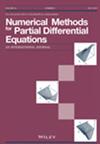Layer‐parallel training of residual networks with auxiliary variable networks
IF 1.7
3区 数学
Q1 MATHEMATICS, APPLIED
引用次数: 0
Abstract
Gradient‐based methods for training residual networks (ResNets) typically require a forward pass of input data, followed by back‐propagating the error gradient to update model parameters, which becomes time‐consuming as the network structure goes deeper. To break the algorithmic locking and exploit synchronous module parallelism in both forward and backward modes, auxiliary‐variable methods have emerged but suffer from communication overhead and a lack of data augmentation. By trading off the recomputation and storage of auxiliary variables, a joint learning framework is proposed in this work for training realistic ResNets across multiple compute devices. Specifically, the input data of each processor is generated from its low‐capacity auxiliary network (AuxNet), which permits the use of data augmentation and realizes forward unlocking. Backward passes are then executed in parallel, each with a local loss function derived from the penalty or augmented Lagrangian (AL) method. Finally, the AuxNet is adjusted to reproduce updated auxiliary variables through an end‐to‐end training process. We demonstrate the effectiveness of our method on ResNets and WideResNets across CIFAR‐10, CIFAR‐100, and ImageNet datasets, achieving speedup over the traditional layer‐serial training approach while maintaining comparable testing accuracy.残差网络与辅助变量网络的层并行训练
基于梯度的残差网络(ResNets)训练方法通常需要前向传递输入数据,然后反向传播误差梯度以更新模型参数,随着网络结构的深入,这种方法变得越来越耗时。为了打破算法锁定,并在前向和后向模式中利用同步模块并行性,辅助变量方法应运而生,但这种方法存在通信开销大和缺乏数据增强的问题。通过权衡辅助变量的重新计算和存储,本文提出了一种联合学习框架,用于在多个计算设备上训练现实的 ResNets。具体来说,每个处理器的输入数据均由其低容量辅助网络(AuxNet)生成,从而允许使用数据增强并实现前向解锁。然后并行执行后向传递,每个后向传递都有一个由惩罚或增强拉格朗日(AL)方法得出的局部损失函数。最后,通过端到端的训练过程,调整 AuxNet 以重现更新的辅助变量。我们在 CIFAR-10、CIFAR-100 和 ImageNet 数据集上展示了我们的方法在 ResNets 和 WideResNets 上的有效性,与传统的层序列训练方法相比,我们的方法实现了提速,同时保持了相当的测试精度。
本文章由计算机程序翻译,如有差异,请以英文原文为准。
求助全文
约1分钟内获得全文
求助全文
来源期刊
CiteScore
7.20
自引率
2.60%
发文量
81
审稿时长
9 months
期刊介绍:
An international journal that aims to cover research into the development and analysis of new methods for the numerical solution of partial differential equations, it is intended that it be readily readable by and directed to a broad spectrum of researchers into numerical methods for partial differential equations throughout science and engineering. The numerical methods and techniques themselves are emphasized rather than the specific applications. The Journal seeks to be interdisciplinary, while retaining the common thread of applied numerical analysis.

 求助内容:
求助内容: 应助结果提醒方式:
应助结果提醒方式:


